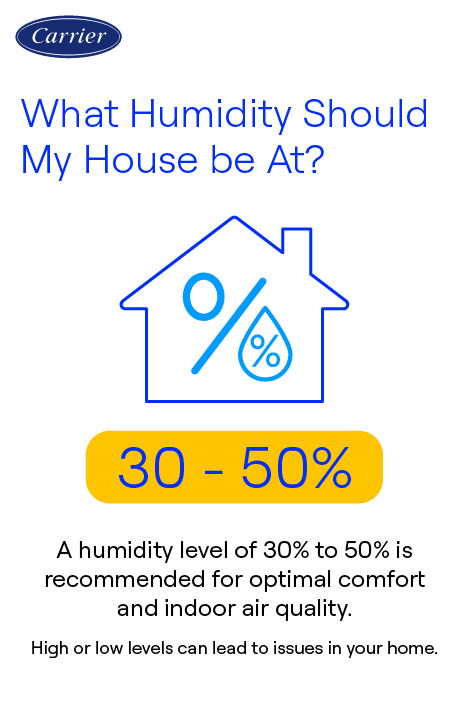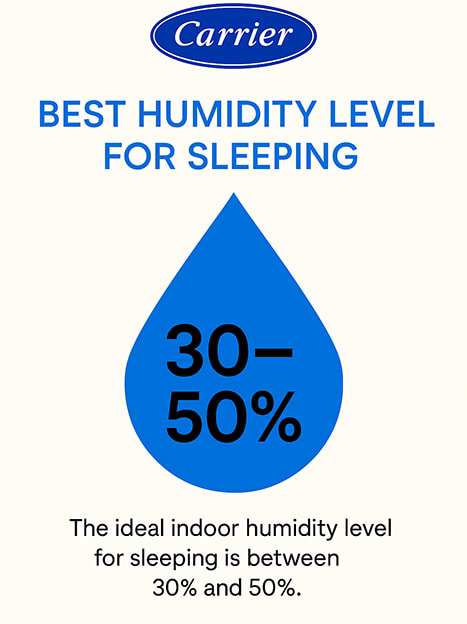Achieving Ideal Indoor Humidity: What Humidity Should My House Be At?
By Travis Baugh
Indoor humidity is essential for maintaining a comfortable and healthy home environment. But what humidity should my house be at? This article explores the ideal indoor humidity range, its importance, and how you can achieve optimal humidity levels.

Why Does Understanding Indoor Humidity Matter?

Indoor humidity plays a crucial role in creating a comfortable and healthy living environment. Whether the air is too dry or too moist, it can significantly affect your health and home’s condition.
“The proper humidity level has a major impact on indoor comfort — in fact, temperature control alone isn’t enough as today’s homes become tighter and more energy efficient,” Kevin Dickson, president of Energy Services Air Conditioning, Heating and Electrical in Naperville, Illinois, said.
Effects Of Low Humidity
Low humidity levels can negatively impact both health and home, leading to discomfort, property damage, and reduced indoor air quality. Maintaining proper moisture levels is essential for a comfortable and well-preserved living space.
“When humidity is too low, the air feels drier than it really is, which can lead to dry skin, irritated sinuses, and even increased static electricity," Dickson said. "It can also cause wood floors, furniture, and trim to crack or warp over time."
Health Issues Caused by Low Humidity
Dry air can cause skin irritation, chapped lips, and dry eyes, leading to discomfort and increased sensitivity. It can also dry out the mucous membranes in the nose and throat, which may make individuals more susceptible to colds, respiratory infections, and allergies. Additionally, low humidity can worsen asthma and bronchitis symptoms due to increased irritation in the airways.
Damage to Furniture, Woodwork, and Electronics
Lack of moisture causes wooden furniture, floors, and musical instruments to crack or warp. Low humidity can also lead to paint chipping and static electricity buildup, which can damage electronics over time.
Effects Of High Humidity
Excessive humidity can create uncomfortable living conditions and lead to various health and home-related issues. Managing indoor humidity levels is crucial for maintaining a healthy and damage-free environment.
"When humidity is too high, the air can feel sticky and uncomfortable, and the excess moisture creates a breeding ground for mold, mildew, and dust mites, all of which can negatively impact indoor air quality and health," Dickson said. "Maintaining proper humidity levels — generally between 30–50% — not only makes the air feel more comfortable but also helps protect your home and supports your family’s health. For many homeowners, adding a whole-home humidifier or dehumidifier is the most effective way to achieve that balance year-round.”
Health Issues
High humidity encourages the growth of mold, mildew, and dust mites, which can trigger allergies, asthma, and respiratory issues. Excess moisture in the air also promotes bacterial growth, increasing the risk of infections. Additionally, humid conditions can make it harder for the body to cool down, leading to heat exhaustion or dehydration.
Damage to Your Home and Belongings
Prolonged high humidity can cause wooden furniture, flooring, and doors to warp or rot. It also damages paint, wallpaper, and insulation, leading to costly repairs. Electronics and appliances may also suffer from moisture-related malfunctions.
What Is the Ideal Indoor Humidity Range?
Maintaining the right humidity levels is crucial for comfort and well-being. So, what humidity should house be at? The ideal indoor humidity range for a house depends on various factors, including the season, climate, and personal preference. Let’s explore the recommended humidity levels for different seasons, understand the 30-60% humidity range, and discover the factors influencing optimal humidity levels.
The 30-60% humidity range is considered optimal for year-round comfort. It strikes a balance between dryness and excess moisture, reducing the chances of health problems and property damage. If you are concerned about the structural integrity of your home and protecting your furniture, flooring, and other belongings, keeping the humidity between 30% and 45% may be best.
Several factors influence the optimal humidity levels for your home:
- Dry climates naturally lower indoor humidity, making it harder to maintain comfortable moisture levels without a humidifier.
- Size of your living space impacts how evenly humidity is distributed, with larger areas requiring more effort to maintain balanced levels.
- Insulation helps retain moisture and temperature, preventing humidity from escaping or being affected by outdoor air.
- Ventilation influences humidity by either introducing dry or moist air, depending on the source and air exchange rate.
Monitoring the humidity using a hygrometer can help you achieve and maintain the ideal range.
Maintaining consistent humidity levels is key to creating a comfortable and healthy indoor environment. You can achieve this by using humidifiers or dehumidifiers, depending on whether you need to add or remove moisture from the air. Carrier offers a range of reliable and efficient humidifiers and dehumidifiers that can help you maintain optimal humidity levels in your home. Learn more about what is a humidifier and what is a dehumidifier.

Best Humidity Level For Home In Winter And Summer
During winter, when the air is typically drier, it’s recommended to keep the humidity level between 30-60%. This helps prevent dry skin, irritated respiratory passages, and static electricity. This range helps maintain comfort while preventing issues like dry skin, static electricity, and respiratory problems. It also protects wooden furniture and flooring from cracking due to low moisture. Using a humidifier can help regulate indoor humidity levels, making your home more comfortable and healthier during the colder months. Keeping humidity within this range also reduces the risk of mold and mildew growth.
During summer, when the air is naturally more humid, it’s advisable to maintain the humidity level between 30-45% according to ASHRAE1. This range helps prevent excess moisture that can lead to mold growth and other issues.
Best Humidity Level For Sleeping

Tips for Achieving Ideal Indoor Humidity
Maintaining the right humidity level in your house is crucial for both your comfort and health. Here are some helpful tips to help you achieve optimal home humidity levels:
Using humidifiers and dehumidifiers effectively
Humidifiers and dehumidifiers are excellent tools for controlling indoor humidity levels. If your home tends to be too dry, especially during the winter months, a humidifier can add moisture to the air, preventing dry skin, irritated sinuses, and static electricity. On the other hand, if your home is too humid, a dehumidifier can remove excess moisture, reducing the risk of mold and mildew growth. Learn more about what does a humidifier do and what does a dehumidifier do.
Ventilation and air circulation strategies
Proper ventilation and air circulation play a significant role in maintaining optimal humidity levels. Make sure your home has adequate ventilation, such as exhaust fans in bathrooms and kitchen areas. Opening windows and using fans can also help improve air circulation, preventing stagnant air and excessive moisture buildup.
Controlling humidity during extreme weather conditions
Extreme weather conditions can impact the humidity levels in your house. During hot and humid summer months, using an air conditioner can help lower indoor humidity. In contrast, during cold winter months, running a humidifier can prevent excessively dry air caused by heating systems.

Connect With A Carrier Dealer To Manage Humidity Levels In Your House
At Carrier, we understand the importance of maintaining ideal indoor humidity levels. Our range of indoor air quality products, including humidifiers and dehumidifiers, are designed to help you manage humidity levels in your house to experience optimal comfort. For expert advice and assistance in achieving the ideal indoor humidity level for your home, connect with your local Carrier dealer. They'll be able to answer any outstanding questions you have on what the humidity should be in your house and provide the best indoor air quality solutions to assist.Frequently Asked Questions About Humidity Home Should Be At
Learn More About Managing Humidity Levels In A House
- Cost to buy or replace a whole-home humidifier
- Explore humidifier benefits
- Furnaces and humidifiers: how they work together
- Whole-home dehumidifier pros & cons
- Cost of a whole-home dehumidifier

